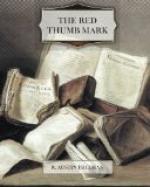“That seems a fair and efficient test,” said his lordship. “Have you any objection to offer, Sir Hector?”
Sir Hector Trumpler hastily consulted with the two experts, who were sitting in the attorney’s bench, and then replied, without much enthusiasm—
“We have no objection to offer, my lord.”
“Then, in that case, I shall direct the expert witnesses to withdraw from the court while the prints are being made.”
In obedience to the judge’s order, Mr. Singleton and his colleague rose and left the court with evident reluctance, while Thorndyke took from a small portfolio three sheets of paper which he handed up to the judge.
“If your lordship,” said he, “will make marks in ten of the squares on two of these sheets, one can be given to the jury and one retained by your lordship to check the third sheet when the prints are made on it.”
“That is an excellent plan,” said the judge; “and, as the information is for myself and the jury, it would be better if you came up and performed the actual stamping on my table in the presence of the foreman of the jury and the counsel for the prosecution and defence.”
In accordance with the judge’s direction Thorndyke stepped up on the dais, and Anstey, as he rose to follow, leaned over towards me.
“You and Polton had better go up too,” said he: “Thorndyke will want your assistance, and you may as well see the fun. I will explain to his lordship.”
He ascended the stairs leading to the dais and addressed a few words to the judge, who glanced in our direction and nodded, whereupon we both gleefully followed our counsel, Polton carrying the box and beaming with delight.
The judge’s table was provided with a shallow drawer which pulled out at the side and which accommodated the box comfortably, leaving the small table-top free for the papers. When the lid of the box was raised, there were displayed a copper inking-slab, a small roller and the twenty-four “pawns” which had so puzzled Polton, and on which he now gazed with a twinkle of amusement and triumph.
“Are those all stamps?” inquired the judge, glancing curiously at the array of turned-wood handles.
“They are all stamps, my lord,” replied Thorndyke, “and each is taken from a different impression of the prisoner’s thumb.”
“But why so many?” asked the judge.
“I have multiplied them,” answered Thorndyke, as he squeezed out a drop of finger-print ink on to the slab and proceeded to roll it out into a thin film, “to avoid the tell-tale uniformity of a single stamp. And I may say,” he added, “that it is highly important that the experts should not be informed that more than one stamp has been used.”
“Yes, I see that,” said the judge. “You understand that, Sir Hector,” he added, addressing the counsel, who bowed stiffly, clearly regarding the entire proceeding with extreme disfavour.




